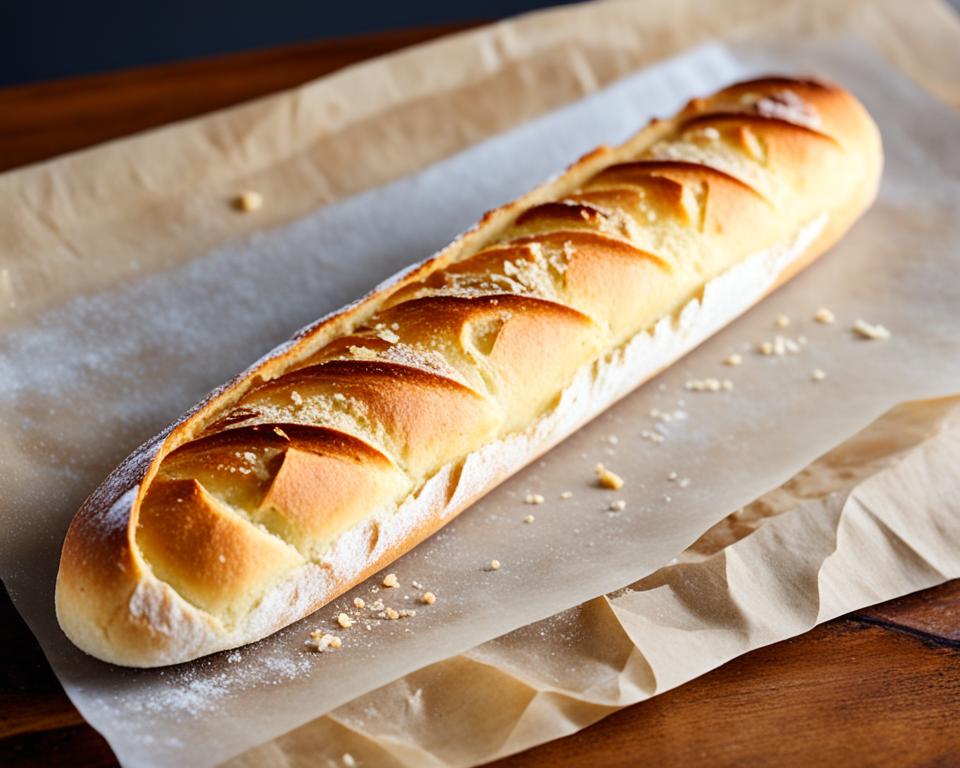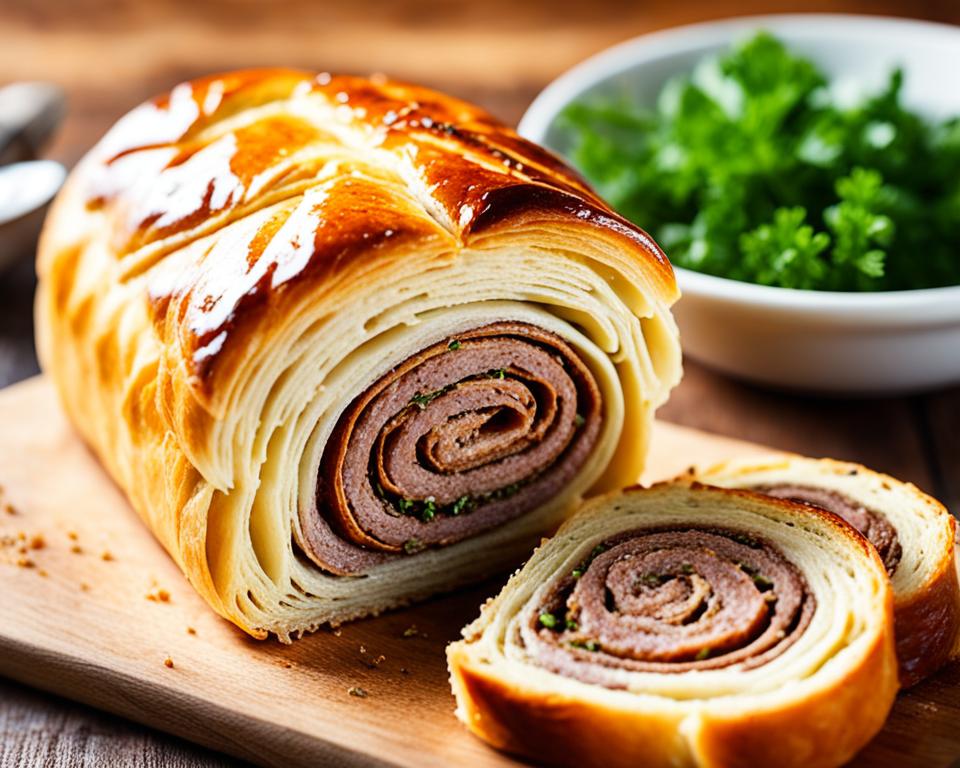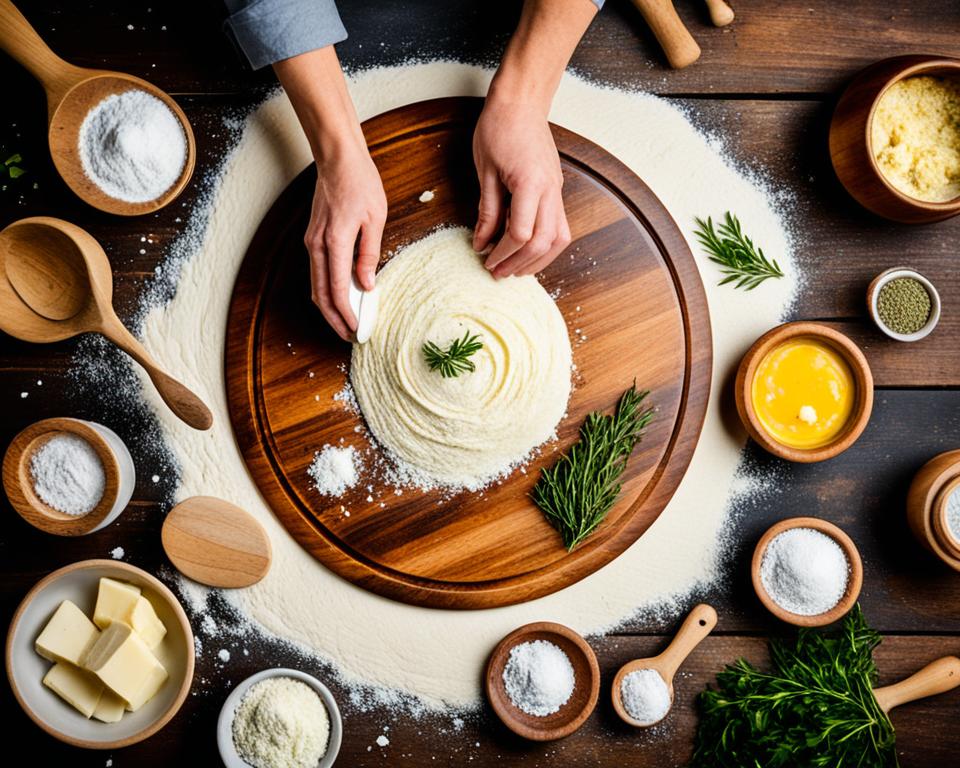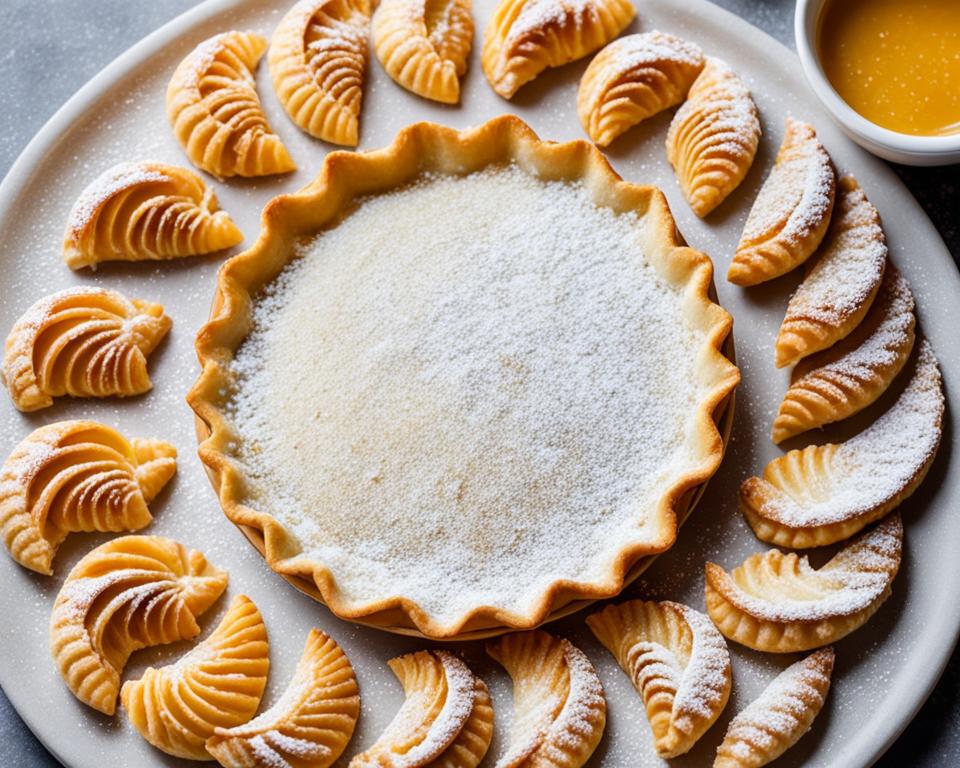Greetings, bread enthusiasts! If you’ve ever dreamed of baking a flaky classic French baguette with a crusty golden loaf that will impress everyone around your table, then you’ve come to the right place. Today, I’ll be sharing with you a foolproof recipe that will elevate your baking skills to pro level. With just four simple ingredients and some key techniques, you’ll be able to create a homemade baguette that rivals those from a French bakery.
There’s something truly magical about a French baguette. Its flaky exterior and airy, chewy interior are truly a culinary delight. The secrets to achieving perfection lie in the way you handle the dough and the time you give it to develop its texture. Not to worry, I’ll guide you through each step so you can bake like a pro.
But first, feast your eyes on this mouthwatering image of a crusty golden French baguette:
Key Takeaways:
- With just four ingredients, you can bake a homemade baguette that rivals those from a bakery.
- Folding the dough instead of kneading helps develop the gluten structure and create a chewy, fluffy interior.
- Resting time is crucial to achieve the characteristic chewy center and well-defined holes in a classic French baguette.
- Using steam during baking is essential for a crispy crust on your baguette.
- Follow the simple recipe and techniques provided to create a flaky classic French baguette at home.
The Secrets to a Perfect Baguette: Fold, Don’t Knead
When it comes to achieving the perfect baguette, there are a few secrets that can make all the difference. One of these secrets is to fold the dough instead of kneading it. This technique helps to develop the gluten structure, resulting in a chewy and fluffy interior. Unlike traditional kneading, folding the dough gently redistributes the yeast and helps to achieve the desired texture.
During the folding process, I carefully fold the dough over itself, stretching and pulling to create layers. This folding technique helps to strengthen the gluten network and trap air within the dough, leading to those signature large air pockets found in a classic baguette. The result is a light and airy interior with a delicate crumb.
Another key element of producing the perfect baguette is allowing the dough to rest at various stages. Resting time is crucial in developing the desired texture, as it allows the gluten to relax and the yeast to work its magic. The dough should be left to rest both after mixing and after each round of folding. This resting period allows the dough to hydrate fully and leads to a more elastic and extensible dough, which in turn contributes to a chewy and hole-filled center.
Resting time also enhances the flavor of the baguette. As the dough rests, the fermentation process continues, creating complex flavors and aromas. So, while it may be tempting to rush through the resting periods to get to the final product, it’s important to exercise patience and allow the dough to develop to its full potential.
Why Fold Instead of Knead?
The folding technique helps to develop the gluten structure, resulting in a chewy and fluffy interior.
When compared to kneading, folding the dough has several advantages. While both techniques contribute to gluten development, folding creates a more irregular and open gluten network, resulting in a lighter crumb and better overall texture. Kneading, on the other hand, can lead to a denser crumb and a less open structure.
Furthermore, the folding technique requires less physical effort compared to kneading, making it a more accessible method for home bakers of all skill levels. It also minimizes the risk of overworking the dough, which can lead to tough baguettes.
So, the next time you’re baking a baguette, remember the secret is in the fold. Exercise patience during the resting periods and enjoy the process of creating the perfect French baguette right in your own kitchen.
Key Takeaways:
- Folding the dough instead of kneading it helps to develop the gluten structure and create a chewy and fluffy interior.
- Resting the dough at various stages is crucial in developing the desired texture and flavor.
- The folding technique creates a more open gluten network and leads to a lighter crumb compared to kneading.
- Be patient during the resting periods and let the dough develop to its full potential.
The Importance of Resting Time
Resting time plays a crucial role in achieving the perfect texture for your baguette. It allows the gluten to relax and develop, resulting in a light and airy interior. Each stage of the recipe includes a resting period, during which the dough is folded and then left to rest. These resting periods contribute to the characteristic chewy center and well-defined holes in a classic French baguette.
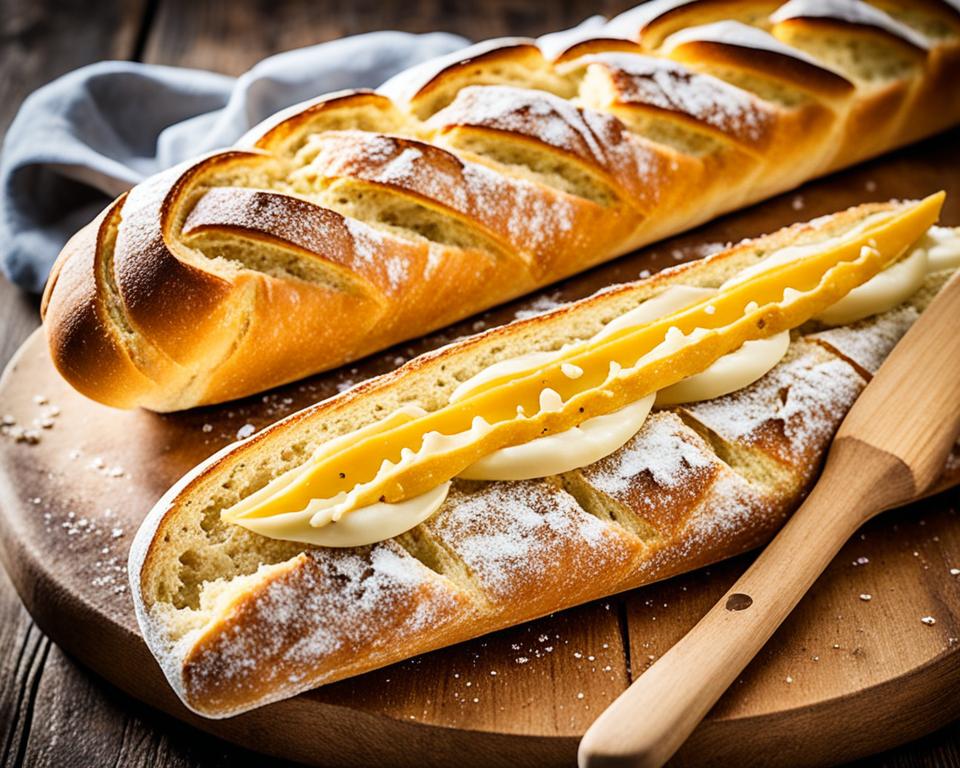
By giving the dough time to rest, you allow the gluten strands to hydrate fully, ensuring a more elastic dough that is easier to shape and handle. Resting also allows the yeast to ferment further, enhancing the flavor of the baguette.
During the resting periods, the gluten relaxes and stretches, resulting in a light and chewy center. The dough’s elasticity is developed, allowing for a well-risen and tender final texture. Resting time is essential for achieving those highly sought-after characteristics.
The Role of Steam in Crispy Crust
The use of steam plays a crucial role in achieving a perfectly crispy crust on your classic French baguette. It’s the secret behind that irresistible golden exterior that makes each bite of your homemade baguette a delight. Let me explain how steam works its magic.
When baking a classic French baguette, steam helps create the ideal conditions for crust formation. It’s what gives the baguette that signature shine and crackle when you take that first bite.
To harness the power of steam, you’ll need to create a steamy environment in your oven. Here’s how:
Preheating with a Pan of Boiling Water
Before placing your baguettes in the oven, preheat it to the desired temperature. Alongside your baking sheet, place a pan filled with boiling water on the bottom rack of the oven. This step creates a steamy atmosphere as the water evaporates, surrounding the dough and contributing to the crust formation.
Adding Extra Steam Before Baking
Just before you put the baguettes in the oven, give them one final boost of steam. Using a spray bottle filled with water, mist the inside of the hot oven. This extra burst of steam ensures a beautifully golden and crunchy crust, characteristic of a classic French baguette.
The combination of preheating the oven with a pan of boiling water and spraying water inside creates a moisture-rich environment. This steamy atmosphere helps the dough expand and rise, while also encouraging crust formation.
| Benefits of Steam in Baguette Baking | Techniques to Achieve Steam |
|---|---|
| Promotes crust formation | Preheating with a pan of boiling water |
| Develops a beautifully golden and crunchy crust | Adding extra steam before baking |
| Enhances the overall texture and appearance of your baguette |
By harnessing the power of steam during the baking process, you can achieve that authentic, bakery-quality crust on your classic French baguette. The steam helps create a moist and shiny exterior while maintaining the desired texture and appearance.
Perfectly crispy on the outside, fluffy on the inside, a classic French baguette with a crispy crust is truly a work of art.
Now that you understand the role of steam in creating a crispy crust, let’s dive into the complete recipe for a flaky classic French baguette in the next section.
The Recipe: Flaky Classic French Baguette
Follow this simple and foolproof recipe to create a flaky classic French baguette at home. With just four basic ingredients—baking flour, salt, yeast, and water—you’ll be on your way to baking a homemade baguette that rivals those from a bakery. Prepare to impress your taste buds with the delightful combination of a crispy crust and tender, airy interior.
Ingredients:
- Baking flour – 500g
- Salt – 10g
- Yeast – 2g
- Water (room temperature) – 350ml
Preparation:
- In a large mixing bowl, combine the baking flour, salt, and yeast.
- Add water gradually while stirring with a wooden spoon, until a sticky dough forms.
- Cover the bowl with a clean kitchen towel and let the dough rest for 2 hours.
- After 2 hours, fold the dough gently to release any air bubbles and shape it into a ball.
- Place the dough back in the bowl, cover, and let it rest for an additional 2 hours.
- Repeat the folding process two more times, at 4-hour intervals.
- Finally, divide the dough into four equal pieces and shape each piece into a baguette form.
- Place the baguettes on a floured surface, cover with a towel, and let them rest for 1 hour.
Baking:
Preheat the oven to 450°F (230°C).
Adding steam is crucial for achieving that crispy crust. Place a baking tray with water on the lower rack of the oven to create steam while the baguettes bake.
With a sharp knife, score the top of each baguette by making diagonal slashes along the length.
Transfer the baguettes to a baking sheet lined with parchment paper and place it in the preheated oven.
Be careful of the steam when opening the oven.
Bake the baguettes for about 16-18 minutes, or until they turn golden brown and sound hollow when tapped on the bottom.
Once baked, remove the baguettes from the oven and let them cool on a wire rack.
Serving:
Enjoy your homemade flaky classic French baguettes warm or at room temperature. Serve them as your favorite sandwich base or simply slice and savor with butter or cheese. The choices are endless!

| Ingredients | Quantity |
|---|---|
| Baking flour | 500g |
| Salt | 10g |
| Yeast | 2g |
| Water (room temperature) | 350ml |
Prep/Fold the Dough
To prepare the dough for your flaky classic French baguette, start by gathering the following ingredients:
- 2 ⅓ cups of bread flour
- 2 teaspoons of salt
- 1 ¼ cups of warm water
- ½ teaspoon of active dry yeast
In a small bowl, mix the yeast with warm water and let it sit for about 5 minutes, or until foamy. This indicates that the yeast is activated and ready to be incorporated into the dough.
In a large mixing bowl, combine the bread flour and salt. Make a well in the center and pour in the yeast mixture. Using a wooden spoon or your hands, gently stir the ingredients together until a sticky dough forms.
If the dough feels too dry, gradually add more warm water, a tablespoon at a time, until the desired consistency is achieved. Remember, the dough should be slightly sticky but not overly wet.
Once the dough is mixed, cover the bowl with a clean kitchen towel or plastic wrap and let it rest for 45 minutes. This resting time allows the gluten to relax and develop, resulting in a more elastic and easy-to-work-with dough.
After the first resting period, it’s time to incorporate the folding technique. This involves a series of four repetitions of folding and resting, each lasting about 30 minutes.
The Folding Technique:
- With lightly floured hands, gently stretch one edge of the dough away from you and fold it towards the center. Repeat this process with the other three sides of the dough, creating a symmetrical shape.
- Rotate the dough 90 degrees and repeat the folding process. Continue rotating and folding the dough for a total of four folds.
- After each fold, cover the dough and let it rest for about 30 minutes. This resting time allows the gluten to strengthen, contributing to the desired texture of the baguette.
By following the folding technique and allowing for proper resting time, you are setting the foundation for a beautifully textured baguette. The folding process helps to develop the gluten structure, enhancing the elasticity of the dough and giving the baguette its characteristic chewy interior.
Now that the dough has been prepared and folded, it’s time to move on to the next step: shaping the dough into the iconic baguette form.
Shape the Dough
After the final resting period, it’s time to shape the dough into beautiful baguettes. Here’s how:
- Take the dough out of the bowl and divide it into four equal pieces.
- Shape each piece into a rectangle and sprinkle it with flour to prevent sticking.
- Fold each rectangle in half lengthwise, creating a crease down the center.
- Gently roll each piece into a 15-inch long log, starting from one end and moving towards the other.
- Once the logs are formed, shape them into the iconic baguette form by tapering the ends and pressing the seam to seal it.
- Place the shaped baguettes on a baking sheet lined with parchment paper or a silicone mat.
- Let the baguettes rest for 30 minutes to allow them to rise slightly and develop their characteristic texture.
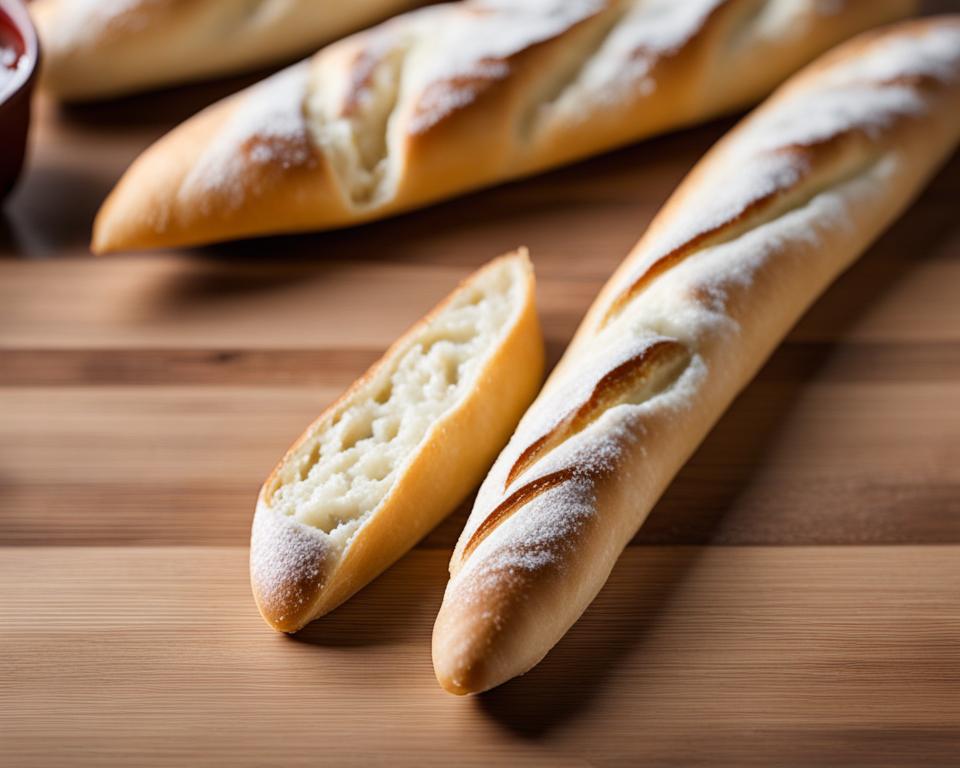
Shape the dough into beautiful baguettes and let them rest before moving on to the final step. This step is crucial in creating the perfect texture and appearance for your homemade baguettes.
Bake the Baguettes
Now that your baguettes are shaped and rested, it’s time to bake them to perfection. Follow these steps to achieve a beautifully golden and crusty baguette:
- Preheat your oven to 450°F (232°C) and place a pan of boiling water at the bottom. This will create steam, which is essential for achieving a crispy crust.
- Carefully transfer the shaped baguettes onto a baking sheet lined with parchment paper. Make sure to leave enough space between each baguette for even baking.
- Score the top of each baguette with a sharp knife or bread lame. This not only adds a decorative touch but also allows steam to escape during baking, resulting in a lighter texture.
- Spray some water inside the oven just before placing the baguettes inside. This extra burst of steam will further enhance the crust formation.
- Place the baking sheet with the baguettes in the preheated oven and bake for 16-18 minutes, or until the baguettes turn deep golden brown in color. To ensure even baking, rotate the baking sheet halfway through the baking time.
- To test if the baguettes are done, tap the bottom of each baguette. It should sound hollow, indicating that they are fully baked.
- Once baked, remove the baguettes from the oven and transfer them to a wire rack to cool completely. This will help the baguettes maintain their crisp crust.
Note: Baking times may vary depending on your oven, so keep a close eye on your baguettes during the final minutes of baking.
Now that your baguettes are perfectly baked, it’s time to slice and enjoy the irresistible combination of a crisp crust and a soft, airy interior. Serve them warm with butter or use them as the base for sandwiches and crostini. The possibilities are endless!
Tips and Variations
Here are some baguette baking tips to ensure success when making your flaky classic French baguettes:
-
Use high-quality ingredients for the best flavor: Opt for top-notch flour, organic yeast, and sea salt to enhance the taste of your baguettes.
-
Follow the folding technique precisely for the desired texture: Folding the dough instead of kneading it helps to develop the gluten structure, resulting in a chewy and fluffy interior. Take your time and don’t skip this essential step.
-
Experiment with different flours for variations on the classic baguette recipe: Try using whole wheat or rye flour to give your baguettes a unique flavor and texture. These variations can add a nutty or earthy taste to your homemade bread.
-
Add herbs, cheese, or olives to the dough for additional flavor variations: Take your baguettes to the next level by incorporating your favorite ingredients into the dough. Fresh herbs, grated cheese, or chopped olives can create savory and aromatic bread.
-
Practice scoring the dough to create beautiful designs on the crust: Scoring the dough not only adds aesthetic appeal, but it also allows the bread to expand properly during baking. Experiment with different patterns and techniques to create unique and artistic designs.
Try out these tips and variations to elevate your baguette baking skills and impress your loved ones with a variety of delicious homemade bread.
Serving and Storing Suggestions
When it comes to serving your freshly baked baguettes, there’s nothing quite like enjoying them warm, straight from the oven. The aroma fills the air, and the crust is at its crispiest perfection. To savor the true delight of a baguette, slice it and pair it with a generous spread of butter or your favorite toppings. Each bite will transport you to the streets of Paris, indulging in the irresistible flavors of classic French cuisine.
Should you have any baguette leftovers, fear not! There are simple ways to store them while preserving their crispy crust and ideal texture. Place the baguettes in a paper bag or loosely wrap them in plastic wrap. This method allows for proper airflow, preventing them from becoming stale. Avoid using airtight containers, as this can cause condensation and result in a soggy baguette.
To bring back the ideal baguette texture of your stored leftovers, follow these steps:
- Preheat your oven to 350°F (175°C) and allow it to fully heat up.
- Place the baguettes directly on the oven rack or on a baking sheet lined with parchment paper.
- Heat the baguettes for 5-7 minutes, or until they are warmed through.
- Remove them from the oven and let them cool for a few minutes before serving.
By reheating the stored baguettes in a preheated oven, you can revive their freshness and recreate the ideal baguette texture. This method ensures that you can enjoy your baguettes as if they were just baked, with their crusty exterior and fluffy interior intact.
Remember, baguettes are best enjoyed fresh, but with these simple serving and storing suggestions, you can make the most of every delicious bite, from the hot-out-of-the-oven experience to the reheating of leftovers.
Quotes:
I can’t resist the warm, crusty goodness of a freshly baked baguette. The way it melts in my mouth is simply divine.
“My favorite way to serve a baguette is with a selection of cheeses and a glass of wine. It’s the perfect appetizer for any occasion.”
Conclusion
Creating the perfect flaky classic French baguette is easier than you think. With this easy-to-follow recipe, you can impress your loved ones with your homemade baguette skills and enjoy the authentic flavors of French bread right in your own kitchen.
One of the secrets to achieving the perfect baguette is to follow the folding technique and allow for proper resting time. This helps develop the gluten structure, resulting in a chewy and fluffy interior. Don’t skip the resting periods, as they contribute to the characteristic chewy center and well-defined holes in a classic French baguette.
In addition, creating steam in the oven is crucial for achieving a crusty golden loaf. Preheating the oven with a pan of boiling water and spraying the oven with water just before baking provides the necessary steam, resulting in a beautifully crunchy exterior. These techniques are essential for recreating the authentic texture of a classic French baguette.
So, why wait? With just a few simple ingredients and some key techniques, you can bake the perfect French bread at home. Say goodbye to store-bought and hello to your very own homemade baguette. Bon appétit!
FAQ
Can I make this recipe using whole wheat or rye flour?
Yes! You can experiment with different flours to create variations on the classic baguette recipe. Using whole wheat or rye flour will give your baguettes a unique flavor and texture.
Can I add herbs, cheese, or olives to the dough?
Absolutely! Adding herbs, cheese, or olives to the dough will add extra flavor and make your baguettes even more delicious. Feel free to get creative with your toppings!
How do I reheat leftover baguettes?
To restore the ideal baguette texture, preheat your oven and place the leftover baguettes in for a few minutes. This will help crisp up the crust and make the bread warm and fresh again.
How should I store the baguettes?
Store your baguettes in a paper bag or wrap them loosely in plastic wrap to maintain their crispy crust. Storing them in an airtight container will soften the crust.
How long does it take to make the baguettes?
The total prep time, including resting periods, is about 8 hours. This allows for the development of gluten and the desired texture, resulting in a perfect flaky classic French baguette.
What ingredients do I need to make the baguettes?
You only need four ingredients: baking flour, salt, yeast, and water. These simple ingredients are all you need to create a delicious homemade baguette.

